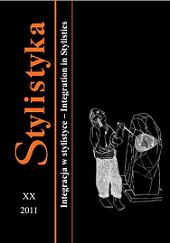Pozice „stylu mluveneho” a „stylu psaneho” v klasifikaci stylu
THE POSITION OF “SPOKEN STYLE” AND “WRITTEN STYLE” IN STYLE CLASSIFICATION
Author(s): Jana HoffmannováSubject(s): Language and Literature Studies
Published by: Uniwersytet Opolski
Keywords: THE SPOKEN; THE WRITTEN; LINGUISTIC MEANS; FUNCTIONAL; COMPLEX; SIMPLEX STYLES; VARIETY; REGISTER; IDIOLECT; SOCIOLECT
Summary/Abstract: This contribution deals with the topic of the spoken and the written from the perspective of stylistics; in this context, attention is devoted to some stylistic concepts which currently appear to be controversial or require some revision. It reacts, among others, to the recently published Polish publication by Kordian Bakuła Mówione ~ pisane: komunikacja, język, tekst (2008) [Spoken ~ Written: Communication, Language, Text] and leans toward the understanding of the spoken and the written as two different styles. The analysis of the written and spoken versions of the same story, told by the same person, is oriented above all toward syntactic differences; it serves as an argument for the claim that spoken and written Czech cannot be understood as two different languages, with a differing repertoire of syntactic structures or grammatical means. Though both versions of the narration differ in many ways, they do so through their overall coloring, atmosphere – it means through their style. The idea of spoken and written style is likely in harmony with that of the conceptual written and spoken (as opposed to the medium-specific; cf. Raible 1994). The spoken and the written are further placed in a relationship to concepts from the area of typology of style. K. Hausenblas (1973) considered the style of spoken and written expression to be simplex styles. Perhaps the term macrostyle would be appropriate for them, though it is oriented to the functional styles in the dictionary by Kožina et al (2003). Of the functional styles, the broadly understood “spoken style” is closest to the Czech terms styl hovorový (prostě sdělovací, běžně mluvený, kolokviální) [colloquial style, simple informative style, everyday spoken style], in Polish potoczny, in Russian razgovornyj. However, it is not possible to unambiguously connect style with a particular realized variety; also, the concept of register most likely refers to a point somewhere in between style and variety. The delimitation of the concepts of idiolect (which is close to individual style) and sociolect (which is close to language variety) is also complicated from this perspective; sometimes, for example, a distinction is made between idiolect and idiostyle.
Journal: Stylistyka
- Issue Year: 2011
- Issue No: XX
- Page Range: 67-79
- Page Count: 13
- Language: Czech

